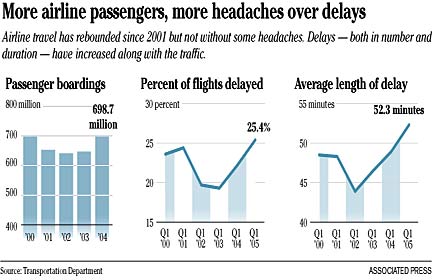
|
Busy summer
expected to
clog airports
With more people flying
and weather a concern, hubs
prepare for the crunch
WASHINGTON » Fliers beware: This summer vacation season could rival 2000, the worst ever for flight delays, cancellations and cranky travelers crammed into airport terminals.
Busy airports with tight security measures could mean especially long lines for this year's summer travelers. And the situation could get even worse if hot, humid air produces a spate of summer thunderstorms -- typically in a zone that stretches from Texas to Michigan -- that are too high to fly over, too dangerous to fly through and often too wide to fly around.
Nationally and here in Hawaii, flight travel is picking up, and analysts are expecting airports to be busier this summer than in 2004. According to state projections, the number of seats filled for incoming mainland flights scheduled between May and July has jumped by 14 percent from last year.
"We're expecting a busy summer," said Sydney Hayakawa, Hawaii director of the federal Transportation Security Administration.
Because of the expected summer rush, Hayakawa plans to convert about 120 part-time airport TSA screeners to full-time. He also plans to hire 66 part-time screeners, who will likely start in June.
He also said that as many of Honolulu Airport's 17 security checkpoints as possible will be kept open, especially during peak flight times.

Even with the high volume of travelers, though, Ishikawa expects waits at security checkpoints to be at most 15 minutes long during the summer peak.
But short security lines will not help those whose flights are canceled or delayed. At hub airports -- especially Chicago's O'Hare International -- bad weather can combine with huge numbers of passengers to cause delays that cascade through the entire system.
That is what happened in 2000, forcing thousands of passengers to sleep on terminal floors or sit fuming while their planes lingered on runways.
Much has been done to improve things since then. Airports have added runways and terminals and improved efficiency, and the Federal Aviation Administration has adopted new strategies.
But the system has yet to be tested during a bad thunderstorm season.
The Memorial Day rush at Washington Dulles International Airport began early yesterday afternoon as security lines ballooned to thousands of travelers -- many of whom were taking advantage of cheap ticket prices.
The average air fare for a 1,000-mile flight is now $118, 20 percent lower than it was in 2000, according to Transportation Department Inspector General Kenneth Mead.
Bargain airfares allowed Nancy Cross, a physician's assistant from Ashburn, Va., to take her husband and two stepdaughters with her to Orlando, Fla., where she was attending a medical conference.
Cross could not believe the security line. "I can't even see where it begins," she said, standing on tiptoes.
At Honolulu Airport, though, officials say they have planned ahead to handle this summer's glut of travelers.
In addition to hiring more screeners, Hayakawa says he will staff security checkpoints with his best operators during busy hours to ensure lines move quickly.
He also said that he is trying to get the word out about what travelers cannot bring on planes, including lighters and scissors. Fewer problems in security lines, he said, mean shorter waits.
Summer traveler outlooks, compiled by the state Department of Business, Economic Development and Tourism, show that the number of scheduled air seats for flights into Honolulu from the mainland between May and July has increased by 13 percent from last year.
There were also increases in international travel, with scheduled air seats from Japan jumping by 10 percent.
Altogether, about 2.6 million seats have been booked for flights to Hawaii between May and July, a 12 percent increase from last year.
Meanwhile, for the first 10 weeks of this year, slightly more flights were delayed nationwide, and delayed longer, than they were during the same period in 2000. Most delays were caused by weather.
At the 55 airports tracked by the FAA, more than 25 percent of flights were delayed for an average of 50 minutes from Jan. 1 to March 15, according to Mead. That is up slightly from 24 percent of flights delayed an average of 48 minutes five years ago.
Mead said yesterday that six airports are likely to experience delays this summer: Philadelphia; New York-LaGuardia; Newark, N.J.; Dulles; Atlanta; and Fort Lauderdale, Fla.
To avoid massive weather disruptions throughout the whole system, the FAA has planned alternate routes based on where storms are likely to develop. "If we have a certain weather pattern, we have a different way of getting them out," FAA chief Marion Blakey said.
The agency also has installed faster and more accurate weather prediction equipment, which allows air traffic controllers and the airlines to respond more quickly to changes in weather systems.
The FAA, though, cannot control the volume of passengers or the number of people who work for the airlines.
Cash-strapped air carriers have slashed their work forces in the past few years to save money. And understaffing was responsible for more than 500,000 US Airways passengers being delayed during the December holidays, according to a report issued by Mead.
The report criticized the way US Airways Group Inc. handled the shortages of fleet service employees and flight attendants, particularly in Philadelphia.
www.tsa.gov/public/
State Airports Division
www.state.hi.us/dot/airports/
E-mail to City Desk
[News] [Business] [Features] [Sports] [Editorial] [Do It Electric!]
[Classified Ads] [Search] [Subscribe] [Info] [Letter to Editor]
[Feedback]
